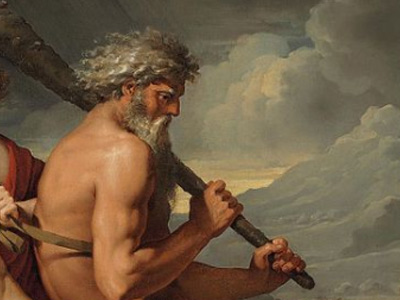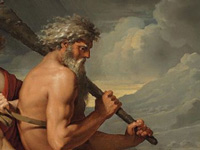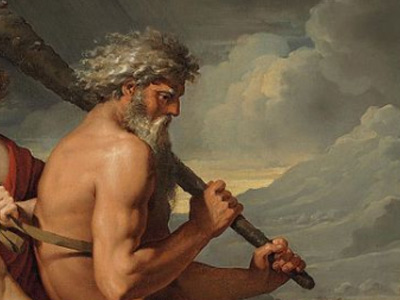Chiron

In Greek mythology, Chiron (pronounced KY-rən /ˈkaɪrən/; also Cheiron or Kheiron; Greek: Χείρων "hand") was held to be the superlative centaur amongst his brethren, as he was called as the "wisest and justest of all the centaurs".
Biography
Chiron was notable throughout Greek mythology for his youth-nurturing nature. His personal skills tend to match those of Apollo, his foster father (sometimes along with Artemis): medicine, music, archery, hunting, gymnastics and the art of prophecy. Chiron was known for his knowledge and skill with medicine and thus, was credited with the discovery of botany and pharmacy, the science of herbs and medicine.
Like satyrs, centaurs were notorious for being wild, lusty, overly indulgent drinkers and carousers, violent when intoxicated, and generally uncultured delinquents. Chiron, by contrast, was intelligent, civilized and kind, because he was not related directly to the other centaurs due to his parentage. He was the son of the Titan Cronus and the Oceanid Philyra.
Chiron lived predominantly on Mount Pelion; there he married the nymph Chariclo who bore him three daughters, Hippe (also known as Melanippe meaning the "black mare" or Euippe, "truly a mare"), Endeïs, and Ocyrhoe, and one son Carystus. A different source also stated that his wife was called Nais.
Like the other centaurs, Chiron was later expelled by the Lapithae from his home; but sacrifices were offered to him there by the Magnesians until a very late period, and the family of the Cheironidae in that neighbourhood, who were distinguished for their knowledge of medicine, were regarded as his descendants.
Physical appearance
Although a centaur, Chiron's physical appearance often differs somewhat from other centaurs, demonstrating his status and heritage. In traditional Greek representations of Chiron his front legs are human, rather than equine, this is in contrast to the traditional representation of centaurs, which have the entire lower body of a horse. This clearly sets Chiron apart from the other centaurs, making him easily identifiable. This difference may also have highlighted Chiron's unique lineage, being the son of Cronus. Chiron is often depicted carrying a branch with dead hares he has caught hanging from it. Chiron is also often depicted wearing clothes, demonstrating he is more civilised and unlike a normal centaur (the only other occasional exceptions to this rule are the centaurs Nessus and Pholus).
The Education of Achilles wall painting, from the basilica in Herculaneum (top right), is one of the most common Roman depictions of Chiron, as he teaches Achilles the lyre. In this version we see Chiron with a fully equine lower body; this is in contrast to the ancient Greek representations in which he has the front legs of a man. In addition to this reconfiguration, Chiron’s appearance is further altered with his ears. Whereas previously human, Chiron’s ears now match those of a satyr; folded over at the top. This rendering creates a more bestial version of Chiron, much more akin to a standard centaur. It may be possible that due to the rise of written sources, Roman artists were inspired by written descriptions of Chiron; simply using the word centaur, rather than having available traditional visual representations. This may then, not be a deliberate reworking of the Chiron myth on the part of the Romans, but simply a lost nuance of the character in its migration from Greece to Rome. As F. Kelsey writes; “The Chiron of our painting, […] has a body like that of the other centaurs, but the prominence of the human element in his nature is no less marked; he is the wise and gentle teacher, the instructor of an art”. Interestingly, Chiron has retained an element of clothing and gained a laurel wreath, suggesting the artist wished to portray nobility, or even divinity, more consistent with the traditional view. It has also been suggested that this fresco is a reproduction of an actual statue in the Roman forum.
Mythology
According to an archaic myth, Chiron was sired by the Titan Cronus when he had taken the form of a horse and impregnated the nymph Philyra. Chiron's lineage was different from other centaurs, who were born of sun and rain cloud, rendered by Greeks of the Classic period as from the union of the king Ixion, consigned to a fiery wheel, and Nephele ("cloud"), which in the Olympian telling Zeus invented to look like Hera. Myths in the Olympian tradition attributed Chiron's uniquely peaceful character and intelligence to Apollo and Artemis teaching him in his younger days. Some sources speculate that Chiron was originally a Thessalian god, later subsumed into the Greek pantheon as a centaur.
A great healer, astrologer, and respected oracle, Chiron was said to be the first among centaurs and highly revered as a teacher and tutor. Among his pupils were many culture heroes: Asclepius, Aristaeus, Ajax, Aeneas, Actaeon, Caeneus, Theseus, Achilles, Jason, Peleus, Telamon, Perseus, sometimes Heracles, Oileus, Phoenix, and in one Byzantine tradition, even Dionysus: According to Ptolemaeus Chennus of Alexandria. "Dionysus was loved by Chiron, from whom he learned chants and dances, the bacchic rites and initiations."
There is also a persistent link with Peleus throughout Chiron's myth. This can be explained that the later was the grandfather of Peleus through his daughter Endeis who married the king of Aegina, Aeacus. Chiron saved the life of Peleus when Acastus tried to kill him by taking his sword and leaving him out in the woods to be slaughtered by the centaurs. Chiron retrieved the sword for Peleus. Chiron then explained to Peleus how to capture the nymph Thetis, leading to their marriage.
Chiron is also connected with the story of the Argonauts, whom he received kindly when they came to his residence on their voyage, for many of the heroes were his friends and pupils.
Death
His nobility is further reflected in the story of his death, as Prometheus sacrificed his life, allowing mankind to obtain the use of fire. As the son of Cronus he was immortal, so it was left to Heracles to arrange a bargain with Zeus to exchange Chiron's immortality for the life of Prometheus, who had been chained to a rock and left to die for his transgressions. Chiron was pierced with an arrow belonging to Heracles that had been treated with the blood of the Hydra, or, in other versions, poison that Chiron had given to the hero when he had been under the honorable centaur’s tutelage. According to a Scholium on Theocritus, this had taken place during the visit of Heracles to the cave of Pholus on Mount Pelion in Thessaly during his fourth labour, defeating the Erymanthian Boar. While they were at supper, Heracles asked for some wine to accompany his meal. Pholus, who ate his food raw, was taken aback. He had been given a vessel of sacred wine by Dionysus sometime earlier, to be kept in trust by the centaurs until the right time for its opening. At Heracles' prompting, Pholus was forced to produce the vessel of sacred wine. The hero, gasping for wine, grabbed it from him and forced it open. Thereupon the vapors of the sacred wine wafted out of the cave and intoxicated the wild centaurs led by Nessus who had gathered outside. They attacked with stones and fir trees the cave which was located in the neighbourhood of Malea. Heracles was forced to shoot many arrows (poisoned with the blood of the Hydra) to drive them back. During the assault, Chiron was hit in the thigh by one of the poisoned arrows. After the centaurs had fled, Pholus emerged from the cave to observe the destruction. Being of a philosophical frame of mind, he pulled one of the arrows from the body of a dead centaur and wondered how such a little thing as an arrow could have caused so much death and destruction. In that instant, he let slip the arrow from his hand and it dropped and hit him in the hoof, killing him instantly. This, however, is open to controversy, because Pholus shared the "civilized centaur" form with Chiron in some art images, and thus would have been immortal.
Ironically, Chiron, the master of the healing arts, could not heal himself and willingly gave up his immortality. For this reason, his half-brother Zeus took pity of him thus placed him among the stars in the sky to be honored. The Greeks identified him as the constellation Centaurus.
In Ovid's poem Fasti Ovid has the hero Hercules visiting Chiron's home on Pelion while the child Achilles is there. While Chiron is examining Hercules' weapons, one of the arrows dipped in Lernaean hydra venom falls on Chiron's left foot and poisons him.
While the old man fingers the foul, poisoned shafts,
An arrow slips out and stabs his left foot.
Chiron groaned and hauled the iron from his flesh
Chiron then tries to use herbs to heal himself, but fails. After nine days with a weeping Achilles looking on, Chiron passes into the stars. Chiron was made a promise by Zeus that as long as he was needed as a trainer of demigods, he will exist in this world. He lives on today as a constellation and an inspiration.
LEGENDS

RESOURCES
This article uses material from the Wikipedia article "Chiron", which is released under the Creative Commons Attribution-Share-Alike License 3.0.
© Stories Preschool. All Rights Reserved.









